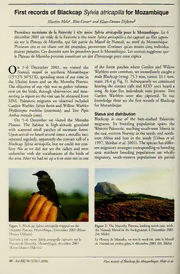
First records of Blackcap Sylvia atricapilla for Mozambique PDF
Preview First records of Blackcap Sylvia atricapilla for Mozambique
^ First records of Blackcap Sylvia atricapilla for Mozambique MartimMeloa Rita Covasa andKlaas-DouweDijkstra , Premieres mentions de la Fauvette a tete noire Sylvia atricapilla pour le Mozambique. Le 6 decembre 2001 un male de la Fauvette a tete noire Sylvia atricapilla a ete capture au filetjapon- ais sur le Plateau de Muretha, qui fait partie du Massifde Namuli, au nord du Mozambique. Plusieurs cris et un chant ont ete entendus, permettant d’estimer qu’au moins cinq individus etaient presents. Ces donnees sont les premieres pour le Mozambique. Les auteurs suggerent que le Plateau de Muretha pourrait constituer un aire d’hivernage pour cette espece. O n 1-6 December 2001, we visited the of the forest patches where Garden and Willow Namuli massif in northern Mozambique Warblers were common, we immediatelycaught a (15°12’S 36°52’E), spending most ofour time in male Blackcap (wing: 73.5 mm, tarsus: 23.1 mm, the Ukalini forest and on the Muretha Plateau. mass: 18.4 g; Fig. 1). Subsequentlywe continued KDD The objective ofour visit was to gather informa- hearing the contact calls and once heard a tion on the birds, through observation and mist- song. At least five individuals were present. Two netting (areporton thevisitcan be obtained from Garden Warblers were also captured. To our MM). Palearctic migrants we observed included knowledge these are the first records ofBlackcap Garden Warbler Sylvia borin and WillowWarbler for Mozambique. Phylloscopus trochilus (common), and Tree Pipit Anthus trivialis (one). Status and distribution On 3-6 December we visited the Muretha Blackcap is one of the best-studied Palearctic Plateau. The habitat is high-altitude grassland migrants. Its breeding population spans the with scattered small patches of montane forest. Western Palearctic, reaching south-west Siberia in Upon arrivalweheardseveraltimesametallictacc the east, western Norwayin the north, and north- , repeated regularly, apparently the contact call ofa west Africa and Iran in the south (Urban et al. Blackcap Sylvia atricapilla but we could not con- 1997, Shirihai etal. 2001). The species has differ- , firm this as we did not see the callers and were entmigratorystrategies correspondingtobreeding unfamiliar with the vocalisations of the birds of area: northern breeding populations are wholly thearea.Afterwehadsetup a6-mmist-netinone migratory, south-western populations are partial Figure 1. BlackcapSylviaatricapillatrappedon the Figure2. TheMurethaPlateau, lookingnorth-east, with Muretha Plateau, Mozambique, December2001 (Klaas- theNamuli Massifin the background, 6 December2001 Douwe Dijkstra) (M. Melo) Fauvetteatete noireSylviaatricapillacapturesurle Le PlateaudeMuretha, vuverslenord-est, avecleMassif Plateau de Muretha, Mozambique, decembre2001 de Namuli en arriere-plan, 6 decembre2001 (M. Melo) (Klaas-Douwe Dijkstra) 80-BullABCVol13No 1(2006) FirstrecordsofBlackcapforMozambique:Meloetal. migrants, andAtlanticandMediterraneanpopula- Acknowledgements tions are largelyresident. Most migrants winter in Ron Demeyencouragedustosubmitthisnote. Peter Africa, some in south-western Europe and a win- Ryan, ClaireSpottiswoodeandCallan Cohenhelped tering population has recentlybecome established in the organisation ofthe trip. RD, CS and CCpro- in Great Britain. In Africa, three wintering areas vided helpful comments on earlier drafts. can be defined: north ofthe Sahara, in the savan- References nas ofWestAfrica and in the highlands ofnorth- east and EastAfrica. The southernmostwintering Cohen, C. 1997. European Blackcap Sylvia atricapilla. population is found in the mountains ofMalawi In Harrison, J. A., Allan, D. G., Under&hill, L. G., Herremans, M.,Tree,A. Parker,V. Brown, C. (c.14°30’S; Urban et al. 1997). There are several J., recent records from the eastern highlands of J. (eds.) TheAtlasofSouthernAfrican Birds. Vol. 2. Johannesburg: BirdLife SouthAfrica. Zimbabwe, very close to the Mozambican border & Parker,V. 2001. Mozambique. InFishpool, L. D. C. (Cohen 1997). Vagrants have been reported in Evans, M. I. (eds.) Important BirdAreas in Africa SouthAfricasince 1985 (Sinclairetal. 1987), sug- andAssociatedIslands:PrioritySitesforConservation. gesting that the species might be a more regular Newbury: Pisces Publications & Cambridge, UK: visitor than currently thought. It may have been BirdLife International. overlooked in the past due to its inconspicuous Ryan, P. G., Bento, C., Cohen, C., Graham,J., Parker, behaviour or the records could indicate an expan- V. & Spottiswoode, C. 1999a. The avifauna and sion ofits wintering range (Cohen 1997). conservation status oftheNamuli Massif, northern Mozambique. BirdConserv. Intern. 9: 315-331. The Namuli Massif Ryan, R, Spottiswoode, C., Parker, V., Graham, J., TheNamuliMassifcontains oneofthemostover- Cohen, C. & Bento, C. 1999b. The birds of looked remnants ofEastern Arc montane forests. Namuli, northernMozambique: retracingVincent’s The ornithological importance of the area was footsteps. Bull.ABC6: 138-143. & demonstratedbyan expedition in 1998, nearly70 Shirihai, H., Gargallo, G. Helbig, A. J. 2001. Sylvia years after it was last visited by a naturalist (Ryan Warblers: Identification, TaxonomyandPhylogeny of eltynaels.i,19M9o9za,ambb)i.qNuaem’uslionAplaylisenAdpaelmiisc\tbhiormdc,icai]s Sincltahier,gJe.nAu.sS&ylvtihae.RLaorintdioesn,CoUmKm:itCthereis1t9o8p7h.erS.HAe.lOm..S. restricted to this area, and two other restricted- Rarities Committee’s annual report. Bokmakierie range species, Cholo Alethe Alethe choloensis and 39: 12-14. & Spot-throat Modulatrix orosthrutus occur. All Urban, E. K., Fry, C. H. Keith, S. (eds.) 1997. Birds three species are of global conservat,ion concern ofAfrica. Vol. 5. London, UK: AcademicPress. (Parker 2001). Our Blackcap records suggest that aInstitute of Evolutionary Biology, University of the Muretha Plateau (and probably other areas of Edinburgh, Kings Buildings, EH9 3JT Edinburgh, theNamuliMassifaswell) mightconstituteawin- UK.E-mail:[email protected], [email protected] teringareaforthespecies, as itoffers ahabitattyp- bGortestraat 11, 2311 MS Leiden, Netherlands. E- ical ofthewinter quarters in EastAfrica and there mail: [email protected] is awintering area further south, in Malawi. Received 26 May2005; revision accepted 5 November 2005 FirstrecordsofBlackcapforMozambique:Meloetal. BullABCVol13No 1(2006)-81
